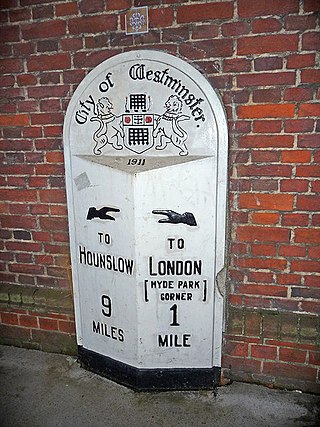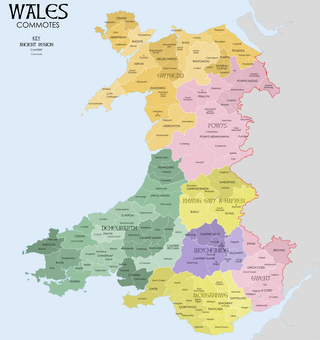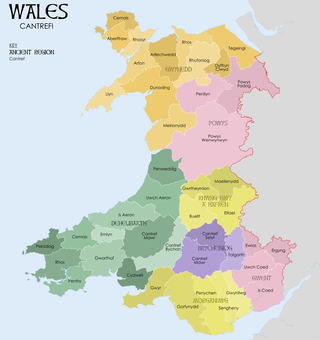Related Research Articles

The mile, sometimes the international mile or statute mile to distinguish it from other miles, is a British imperial unit and United States customary unit of length; both are based on the older English unit of length equal to 5,280 English feet, or 1,760 yards. The statute mile was standardised between the Commonwealth of Nations and the United States by an international agreement in 1959, when it was formally redefined with respect to SI units as exactly 1,609.344 metres.

Owain ap Gruffydd, commonly known as Owain Glyndŵr was a Welsh leader, soldier and military commander in the late Middle Ages, who led a 15-year-long Welsh revolt with the aim of ending English rule in Wales. He was an educated lawyer, forming the first Welsh parliament under his rule, and was the last native-born Welshman to claim the title Prince of Wales.

The yard is an English unit of length in both the British imperial and US customary systems of measurement equalling 3 feet or 36 inches. Since 1959 it has been by international agreement standardized as exactly 0.9144 meter. A distance of 1,760 yards is equal to 1 mile.

Cunedda ap Edern, also called Cunedda Wledig, was an important early Welsh leader, and the progenitor of the Royal dynasty of Gwynedd, one of the very oldest of Western Europe.

Cadwaladr ap Cadwallon was king of Gwynedd in Wales from around 655 to 664 or 682. He died in one of two devastating plagues that happened in 664 and in 682. Little else is known of his reign.

Trefriw is a village and community in Conwy County Borough, Wales. It lies on the river Crafnant a few miles south of the site of the Roman fort of Canovium, sited at Caerhun. At the last three censuses, the population of the community has been recorded as 842 in 1999, 915 in 2001, and 783 in 2011.

The carucate or carrucate was a medieval unit of land area approximating the land a plough team of eight oxen could till in a single annual season. It was known by different regional names and fell under different forms of tax assessment.
Rhun ap Maelgwn Gwynedd, also known as Rhun Hir ap Maelgwn Gwynedd, sometimes spelt as 'Rhûn', was King of Gwynedd. He came to the throne on the death of his father, King Maelgwn Gwynedd. There are no historical records of his reign in this early age. A story preserved in both the Venedotian Code and an elegy by Taliesin says that he waged a war against Rhydderch Hael of Alt Clut and the kings of Gododdin or Manaw Gododdin. The small scattered settlement of Caerhun in the Conwy valley is said to be named for him, though without strong authority. Rhun also appears in several medieval literary stories, as well as in the Welsh Triads. His wife was Perwyr ferch Rhûn "Ryfeddfawr" and their son was Beli ap Rhun "Hîr".

Aberffraw is a village and community on the south west coast of the Isle of Anglesey in Wales. The village is 9 miles from the island's county town, Llangefni, and is on the west bank of the Afon Ffraw. The community includes Soar and Dothan. It is on the A4080 and the nearest rail station is Bodorgan.

A commote was a secular division of land in Medieval Wales. The word derives from the prefix cym- and the noun bod. The English word "commote" is derived from the Middle Welsh cymwt.

Cyfraith Hywel, also known as Welsh law, was the system of law practised in medieval Wales before its final conquest by England. Subsequently, the Welsh law's criminal codes were superseded by the Statute of Rhuddlan in AD 1284 and its civil codes by Henry VIII's series of Laws in Wales Acts between 1535 and 1542.

Aber-erch is a small village and former civil parish on the Llŷn Peninsula in the Welsh county of Gwynedd. The village lies approximately 1 mile (1.6 km) east of Pwllheli. A river, the Afon Erch runs through the village.

Bleddyn ap Cynfyn, sometimes spelled Blethyn, was an 11th century Welsh king. King Harold Godwinson and Tostig Godwinson installed Bleddyn and his brother, Rhiwallon, as the co-rulers of kingdom of Gwynedd on his father's death in 1063, during their destruction of the kingdom of their half-brother, king Gruffydd ap Llywelyn. Bleddyn became king of Powys and co-ruler of the Kingdom of Gwynedd with his brother Rhiwallon from 1063 to 1075. His descendants continued to rule Powys as the House of Mathrafal.

A cantref was a medieval Welsh land division, particularly important in the administration of Welsh law.

Powys Fadog was the northern portion of the former princely realm of Powys. The princes of Powys Fadog would build their royal seat at Castell Dinas Brân, and their religious center at Valle Crucis Abbey. Some of its lordships included those of Maelor, Mochnant, Glyndyfrdwy, Yale, and Bromfield and Yale. Following the division of Powys, their cousin branch, the princes of Powys Wenwynwyn, would build Powis Castle.

Arwystli was a cantref in mid Wales in the Middle Ages, located in the headland of the River Severn. It was chiefly associated with the Kingdom of Powys, but was heavily disputed between Powys, Gwynedd, and the Norman Marcher Lords for hundreds of years, and was the scene of many skirmishes between those groups. Like many other cantrefs and subdivisions, it was divided up by the Laws in Wales Acts in the 16th century.

St Caian's Church, Tregaian, also known as St Caean's Church, Tregaean, is a small medieval church dating from the 14th century in Anglesey, north Wales. It is dedicated to St Caian, a Christian from the 5th or 6th century about whom little is known. The building contains a late 14th-century east window and a late 15th-century doorway. The churchyard contains the grave of William ap Howel, who died in 1581 at the age of 105, leaving over forty children between the ages of 8 and 89 and over three hundred living descendants.
The maenor was a gathering of villages in medieval Wales. In North Wales the word maenol was used for a similar, but not identical, idea.
The Black Book of Chirk is a 13th-century Welsh-language manuscript, known also as the Chirk Codex. It is Peniarth 29 of the National Library of Wales, and deals with legal and historical matters. It contains also an elegy addressed at Llywelyn ap Iorwerth; king of Wales. This poem was probably written by his grandson Llywelyn ap Gruffudd who lived in the 13th century.

Aneurin Owen was a Welsh historical scholar.
References
Citations
- ↑ Owen (1841), Book II, Ch. XVII, §2.
- ↑ Owen (1841), Book III, Ch. VI, §11.
- ↑ Owen (1841), Book II, Ch. XII, §2.
- 1 2 3 4 5 6 7 Owen (1841), Book II, Ch. XVII, §5.
- 1 2 3 4 5 6 7 8 Owen (1841), Book II, Ch. XVII, §6.
- ↑ Roche (1998), p. 25.
- 1 2 3 4 5 Owen (1841), Book II, Ch. XII, §1.
- 1 2 Lewis (1913), p. 42.
- 1 2 3 Wade-Evans (1909), p. 339.
- 1 2 3 4 5 Owen (1841), p. 81.
- ↑ Williams (1869), p. 500.
- 1 2 3 4 5 Wade-Evans (1909), p. 344.
- ↑ Owen (1841), Book II, Ch. XVII, §7.
- ↑ Owen (1841), Book II, Ch. XVII, §8.
- ↑ Owen (1841), Book II, Ch. XVII, §9.
- ↑ Owen (1841), Book II, Ch. XVII, §10.
- ↑ Owen (1841), Book II, Ch. XVII, §11.
- 1 2 Owen (1841), Book II, Ch. XVII, §12.
- ↑ Owen (1841), Book II, Ch. XVII, §13.
- ↑ Jones (2007), note 5.
Bibliography
- Lewis, Timothy (1913), A glossary of mediaeval Welsh law, based upon the Black book of Chirk, Manchester: University Press.
- Owen, Aneurin, ed. (1841), "The Venedotian Code", Ancient Laws and Institutes of Wales; Comprising Laws Supposed to be Enacted by Howel the Good, Modified by Subsequent Regulations under the Native Princes prior to the Conquest by Edward the First: And Anomalous Laws, Consisting Principally of Institutions which by the Statute of Ruddlan were Admitted to Continue in Force: With an English Translation of the Welsh Text, to which are Added A few Latin Transcripts, Containing Digests of the Welsh Laws, Principally of the Dimetian Code, London: Commissioners on the Public Records of the Kingdom . (in Welsh) & (in English)
- Roche, John J. (1998), The Mathematics of Measurement: A Critical History, London: Athlone Press, ISBN 0-387-91581-8 .
- Wade-Evans, Arthur (1909), , Oxford: Clarendon Press.
- Wade-Evans, Arthur (2007), "The Laws of Hywel Dda: Harleian MS 4353 (V) with emendations from Cleopatra A XIV (W), ca. 1285", in Jones, Mary (ed.), Celtic Literature Collective, retrieved 1 February 2013.
- Williams, Jane (1869) [Republished at Cambridge by Cambridge University Press in 2010], A History of Wales: Derived from Authentic Sources, ISBN 978-1-108-02085-5 .